Legal and Contractual Requirements for Public and Private Sectors
VerifiedAdded on 2022/01/15
|9
|3630
|171
Report
AI Summary
This report delves into the legal and contractual requirements within the construction industry, differentiating between public and private sectors. It analyzes the sources of Hong Kong law and the importance of legally binding contracts, emphasizing the use of standard forms in both sectors. Task 1 focuses on a residential building project, recommending a lump sum with quantities contract as the most suitable procurement strategy, detailing its advantages such as cost control and risk balance. Task 2 explores the tendering process for public infrastructure projects, advocating for open competitive tendering to ensure fairness and transparency while acknowledging potential drawbacks. The report also contrasts and compares the contractual requirements of public and private stakeholders, highlighting their differing priorities and the selection processes they employ, including open, selective, and negotiated tendering methods. The conclusion emphasizes the importance of balancing technical aspects and pricing in selecting the most suitable contractor.
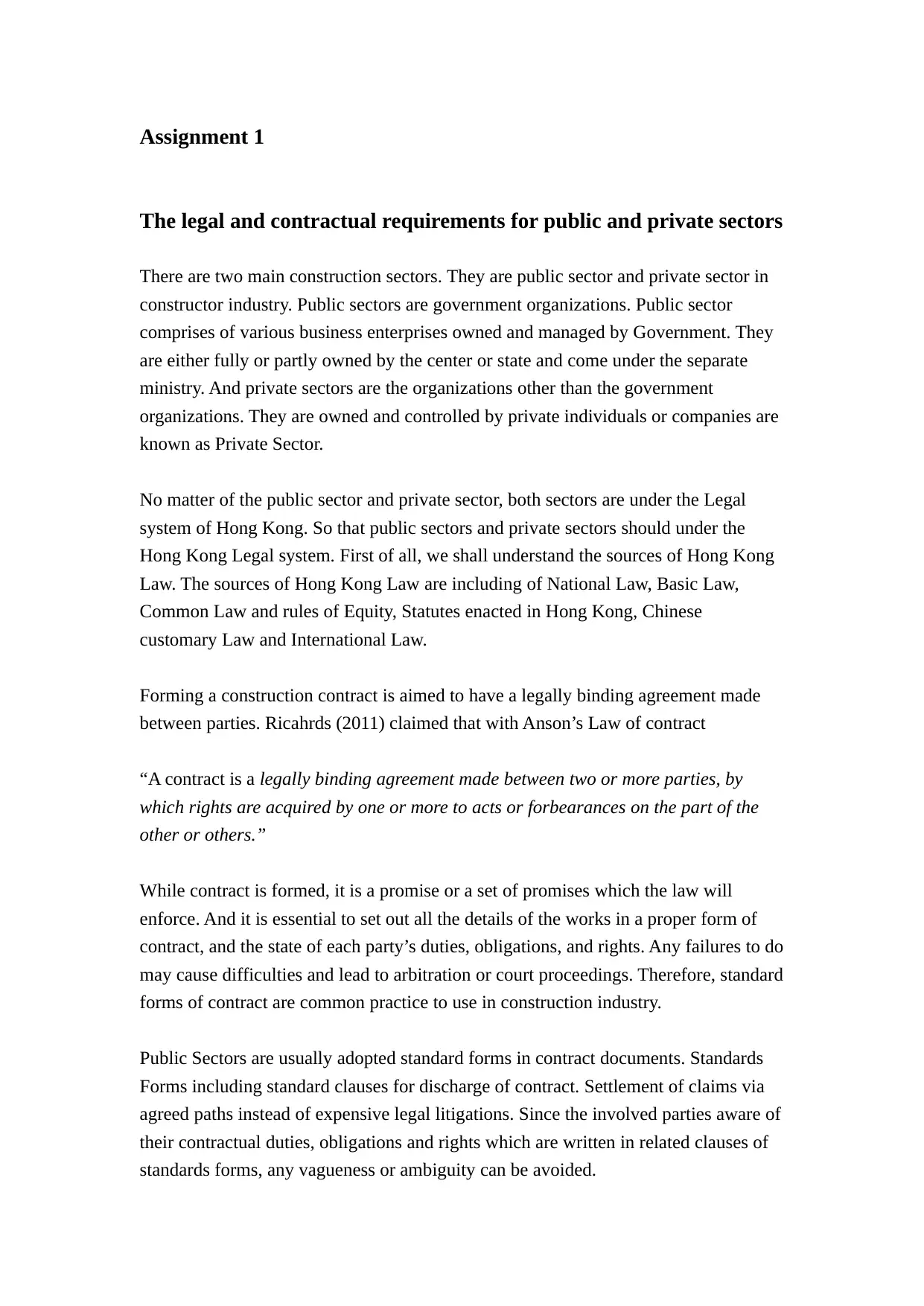
Assignment 1
The legal and contractual requirements for public and private sectors
There are two main construction sectors. They are public sector and private sector in
constructor industry. Public sectors are government organizations. Public sector
comprises of various business enterprises owned and managed by Government. They
are either fully or partly owned by the center or state and come under the separate
ministry. And private sectors are the organizations other than the government
organizations. They are owned and controlled by private individuals or companies are
known as Private Sector.
No matter of the public sector and private sector, both sectors are under the Legal
system of Hong Kong. So that public sectors and private sectors should under the
Hong Kong Legal system. First of all, we shall understand the sources of Hong Kong
Law. The sources of Hong Kong Law are including of National Law, Basic Law,
Common Law and rules of Equity, Statutes enacted in Hong Kong, Chinese
customary Law and International Law.
Forming a construction contract is aimed to have a legally binding agreement made
between parties. Ricahrds (2011) claimed that with Anson’s Law of contract
“A contract is a legally binding agreement made between two or more parties, by
which rights are acquired by one or more to acts or forbearances on the part of the
other or others.”
While contract is formed, it is a promise or a set of promises which the law will
enforce. And it is essential to set out all the details of the works in a proper form of
contract, and the state of each party’s duties, obligations, and rights. Any failures to do
may cause difficulties and lead to arbitration or court proceedings. Therefore, standard
forms of contract are common practice to use in construction industry.
Public Sectors are usually adopted standard forms in contract documents. Standards
Forms including standard clauses for discharge of contract. Settlement of claims via
agreed paths instead of expensive legal litigations. Since the involved parties aware of
their contractual duties, obligations and rights which are written in related clauses of
standards forms, any vagueness or ambiguity can be avoided.
The legal and contractual requirements for public and private sectors
There are two main construction sectors. They are public sector and private sector in
constructor industry. Public sectors are government organizations. Public sector
comprises of various business enterprises owned and managed by Government. They
are either fully or partly owned by the center or state and come under the separate
ministry. And private sectors are the organizations other than the government
organizations. They are owned and controlled by private individuals or companies are
known as Private Sector.
No matter of the public sector and private sector, both sectors are under the Legal
system of Hong Kong. So that public sectors and private sectors should under the
Hong Kong Legal system. First of all, we shall understand the sources of Hong Kong
Law. The sources of Hong Kong Law are including of National Law, Basic Law,
Common Law and rules of Equity, Statutes enacted in Hong Kong, Chinese
customary Law and International Law.
Forming a construction contract is aimed to have a legally binding agreement made
between parties. Ricahrds (2011) claimed that with Anson’s Law of contract
“A contract is a legally binding agreement made between two or more parties, by
which rights are acquired by one or more to acts or forbearances on the part of the
other or others.”
While contract is formed, it is a promise or a set of promises which the law will
enforce. And it is essential to set out all the details of the works in a proper form of
contract, and the state of each party’s duties, obligations, and rights. Any failures to do
may cause difficulties and lead to arbitration or court proceedings. Therefore, standard
forms of contract are common practice to use in construction industry.
Public Sectors are usually adopted standard forms in contract documents. Standards
Forms including standard clauses for discharge of contract. Settlement of claims via
agreed paths instead of expensive legal litigations. Since the involved parties aware of
their contractual duties, obligations and rights which are written in related clauses of
standards forms, any vagueness or ambiguity can be avoided.
Paraphrase This Document
Need a fresh take? Get an instant paraphrase of this document with our AI Paraphraser
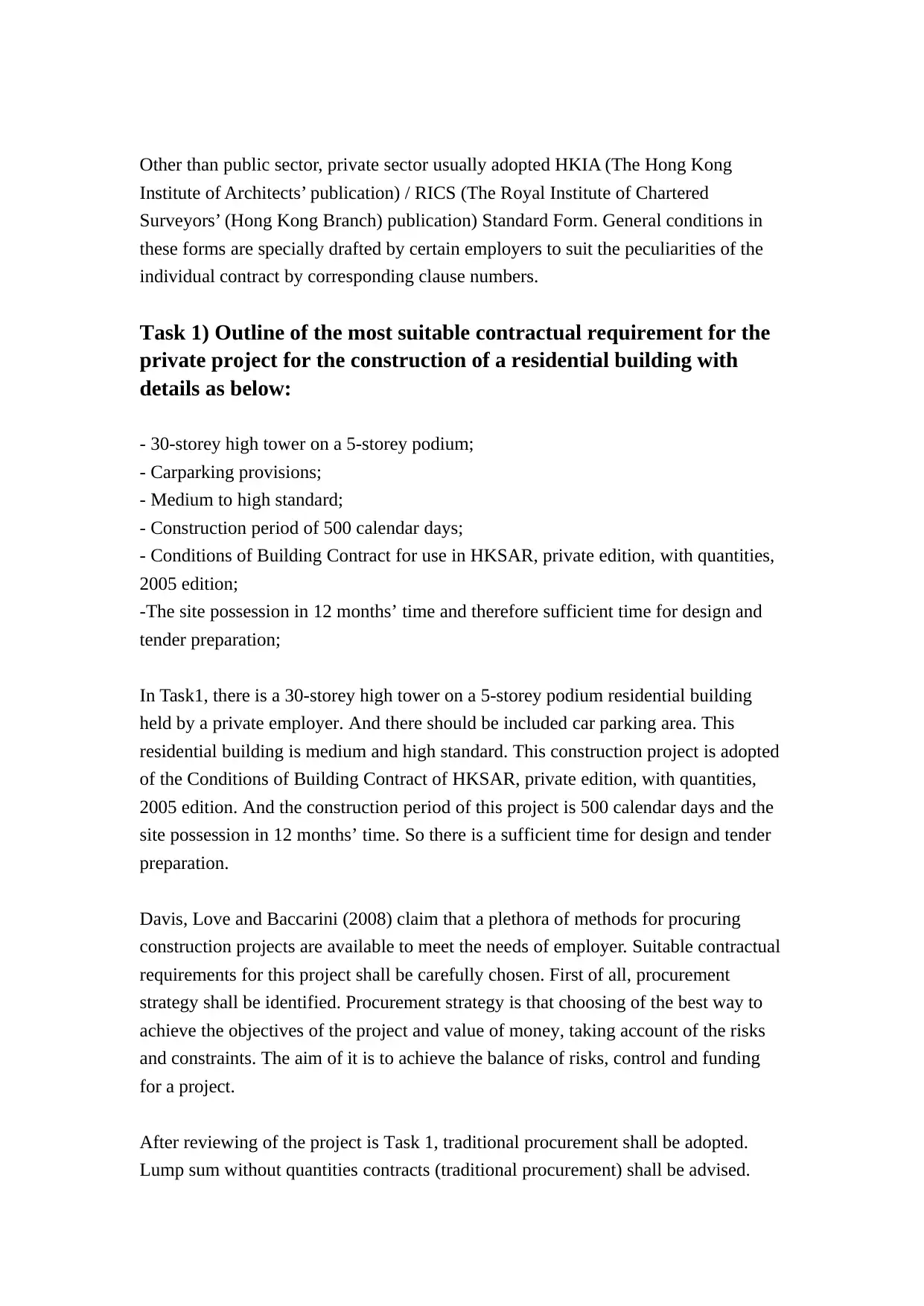
Other than public sector, private sector usually adopted HKIA (The Hong Kong
Institute of Architects’ publication) / RICS (The Royal Institute of Chartered
Surveyors’ (Hong Kong Branch) publication) Standard Form. General conditions in
these forms are specially drafted by certain employers to suit the peculiarities of the
individual contract by corresponding clause numbers.
Task 1) Outline of the most suitable contractual requirement for the
private project for the construction of a residential building with
details as below:
- 30-storey high tower on a 5-storey podium;
- Carparking provisions;
- Medium to high standard;
- Construction period of 500 calendar days;
- Conditions of Building Contract for use in HKSAR, private edition, with quantities,
2005 edition;
-The site possession in 12 months’ time and therefore sufficient time for design and
tender preparation;
In Task1, there is a 30-storey high tower on a 5-storey podium residential building
held by a private employer. And there should be included car parking area. This
residential building is medium and high standard. This construction project is adopted
of the Conditions of Building Contract of HKSAR, private edition, with quantities,
2005 edition. And the construction period of this project is 500 calendar days and the
site possession in 12 months’ time. So there is a sufficient time for design and tender
preparation.
Davis, Love and Baccarini (2008) claim that a plethora of methods for procuring
construction projects are available to meet the needs of employer. Suitable contractual
requirements for this project shall be carefully chosen. First of all, procurement
strategy shall be identified. Procurement strategy is that choosing of the best way to
achieve the objectives of the project and value of money, taking account of the risks
and constraints. The aim of it is to achieve the balance of risks, control and funding
for a project.
After reviewing of the project is Task 1, traditional procurement shall be adopted.
Lump sum without quantities contracts (traditional procurement) shall be advised.
Institute of Architects’ publication) / RICS (The Royal Institute of Chartered
Surveyors’ (Hong Kong Branch) publication) Standard Form. General conditions in
these forms are specially drafted by certain employers to suit the peculiarities of the
individual contract by corresponding clause numbers.
Task 1) Outline of the most suitable contractual requirement for the
private project for the construction of a residential building with
details as below:
- 30-storey high tower on a 5-storey podium;
- Carparking provisions;
- Medium to high standard;
- Construction period of 500 calendar days;
- Conditions of Building Contract for use in HKSAR, private edition, with quantities,
2005 edition;
-The site possession in 12 months’ time and therefore sufficient time for design and
tender preparation;
In Task1, there is a 30-storey high tower on a 5-storey podium residential building
held by a private employer. And there should be included car parking area. This
residential building is medium and high standard. This construction project is adopted
of the Conditions of Building Contract of HKSAR, private edition, with quantities,
2005 edition. And the construction period of this project is 500 calendar days and the
site possession in 12 months’ time. So there is a sufficient time for design and tender
preparation.
Davis, Love and Baccarini (2008) claim that a plethora of methods for procuring
construction projects are available to meet the needs of employer. Suitable contractual
requirements for this project shall be carefully chosen. First of all, procurement
strategy shall be identified. Procurement strategy is that choosing of the best way to
achieve the objectives of the project and value of money, taking account of the risks
and constraints. The aim of it is to achieve the balance of risks, control and funding
for a project.
After reviewing of the project is Task 1, traditional procurement shall be adopted.
Lump sum without quantities contracts (traditional procurement) shall be advised.
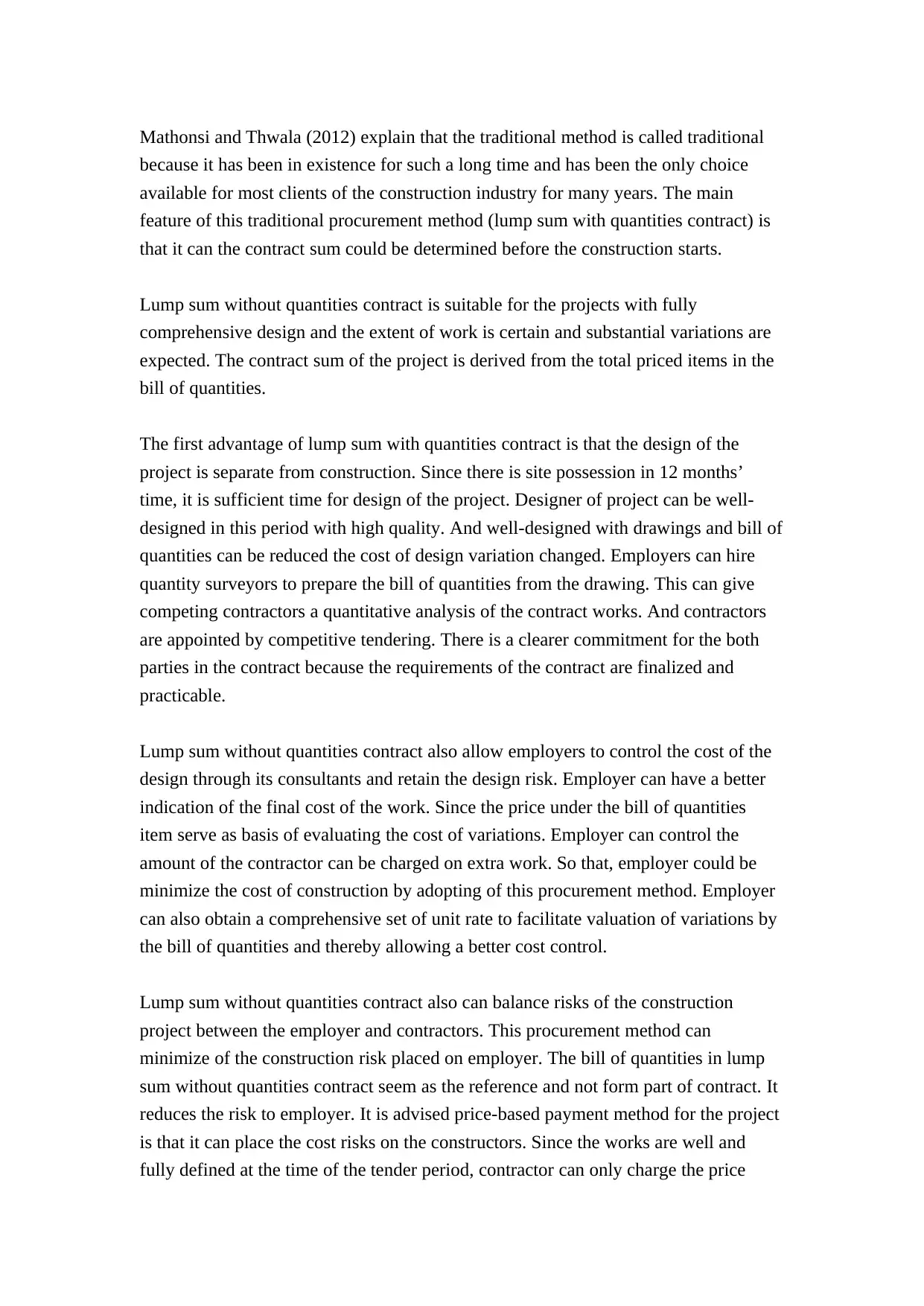
Mathonsi and Thwala (2012) explain that the traditional method is called traditional
because it has been in existence for such a long time and has been the only choice
available for most clients of the construction industry for many years. The main
feature of this traditional procurement method (lump sum with quantities contract) is
that it can the contract sum could be determined before the construction starts.
Lump sum without quantities contract is suitable for the projects with fully
comprehensive design and the extent of work is certain and substantial variations are
expected. The contract sum of the project is derived from the total priced items in the
bill of quantities.
The first advantage of lump sum with quantities contract is that the design of the
project is separate from construction. Since there is site possession in 12 months’
time, it is sufficient time for design of the project. Designer of project can be well-
designed in this period with high quality. And well-designed with drawings and bill of
quantities can be reduced the cost of design variation changed. Employers can hire
quantity surveyors to prepare the bill of quantities from the drawing. This can give
competing contractors a quantitative analysis of the contract works. And contractors
are appointed by competitive tendering. There is a clearer commitment for the both
parties in the contract because the requirements of the contract are finalized and
practicable.
Lump sum without quantities contract also allow employers to control the cost of the
design through its consultants and retain the design risk. Employer can have a better
indication of the final cost of the work. Since the price under the bill of quantities
item serve as basis of evaluating the cost of variations. Employer can control the
amount of the contractor can be charged on extra work. So that, employer could be
minimize the cost of construction by adopting of this procurement method. Employer
can also obtain a comprehensive set of unit rate to facilitate valuation of variations by
the bill of quantities and thereby allowing a better cost control.
Lump sum without quantities contract also can balance risks of the construction
project between the employer and contractors. This procurement method can
minimize of the construction risk placed on employer. The bill of quantities in lump
sum without quantities contract seem as the reference and not form part of contract. It
reduces the risk to employer. It is advised price-based payment method for the project
is that it can place the cost risks on the constructors. Since the works are well and
fully defined at the time of the tender period, contractor can only charge the price
because it has been in existence for such a long time and has been the only choice
available for most clients of the construction industry for many years. The main
feature of this traditional procurement method (lump sum with quantities contract) is
that it can the contract sum could be determined before the construction starts.
Lump sum without quantities contract is suitable for the projects with fully
comprehensive design and the extent of work is certain and substantial variations are
expected. The contract sum of the project is derived from the total priced items in the
bill of quantities.
The first advantage of lump sum with quantities contract is that the design of the
project is separate from construction. Since there is site possession in 12 months’
time, it is sufficient time for design of the project. Designer of project can be well-
designed in this period with high quality. And well-designed with drawings and bill of
quantities can be reduced the cost of design variation changed. Employers can hire
quantity surveyors to prepare the bill of quantities from the drawing. This can give
competing contractors a quantitative analysis of the contract works. And contractors
are appointed by competitive tendering. There is a clearer commitment for the both
parties in the contract because the requirements of the contract are finalized and
practicable.
Lump sum without quantities contract also allow employers to control the cost of the
design through its consultants and retain the design risk. Employer can have a better
indication of the final cost of the work. Since the price under the bill of quantities
item serve as basis of evaluating the cost of variations. Employer can control the
amount of the contractor can be charged on extra work. So that, employer could be
minimize the cost of construction by adopting of this procurement method. Employer
can also obtain a comprehensive set of unit rate to facilitate valuation of variations by
the bill of quantities and thereby allowing a better cost control.
Lump sum without quantities contract also can balance risks of the construction
project between the employer and contractors. This procurement method can
minimize of the construction risk placed on employer. The bill of quantities in lump
sum without quantities contract seem as the reference and not form part of contract. It
reduces the risk to employer. It is advised price-based payment method for the project
is that it can place the cost risks on the constructors. Since the works are well and
fully defined at the time of the tender period, contractor can only charge the price
⊘ This is a preview!⊘
Do you want full access?
Subscribe today to unlock all pages.

Trusted by 1+ million students worldwide
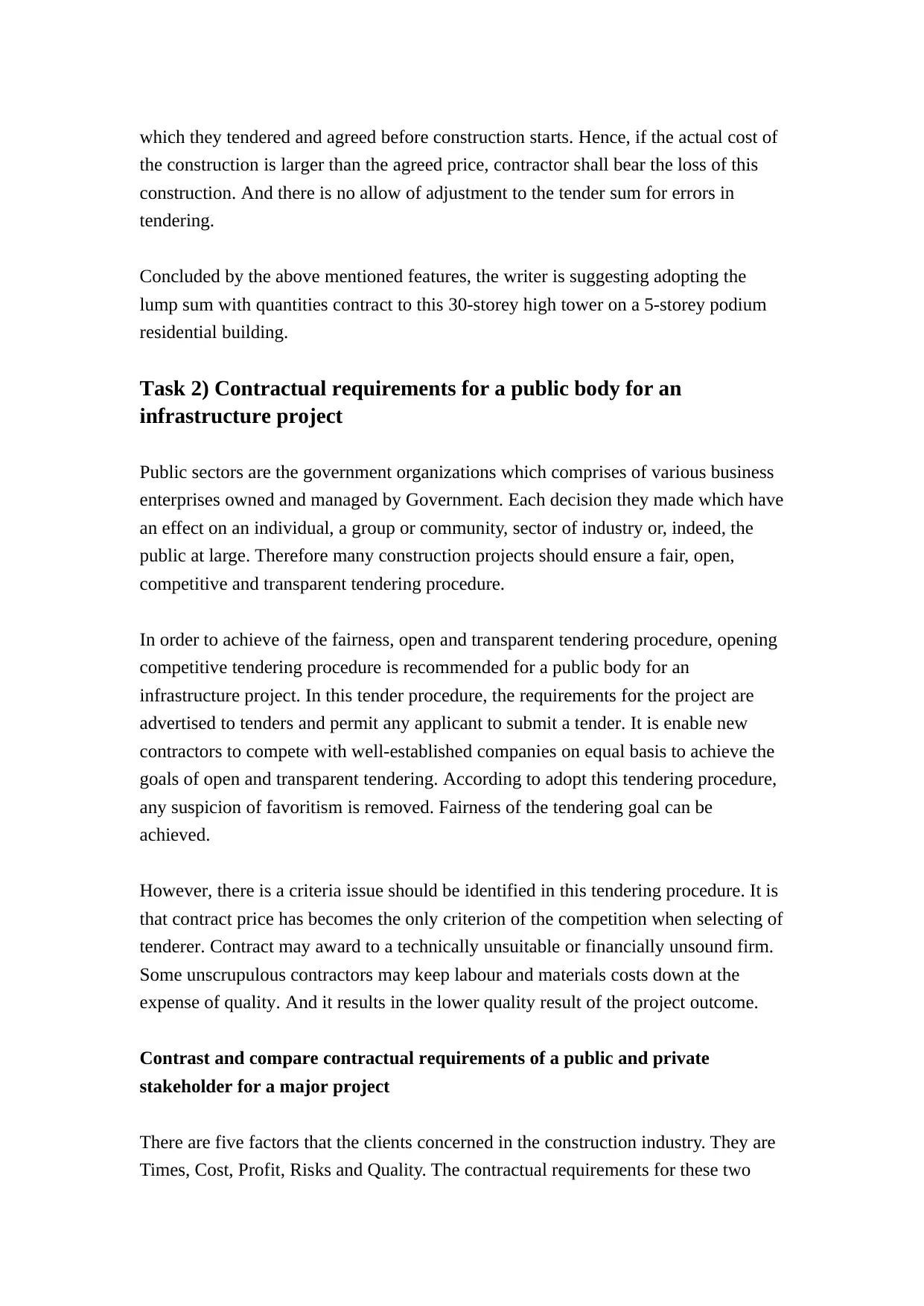
which they tendered and agreed before construction starts. Hence, if the actual cost of
the construction is larger than the agreed price, contractor shall bear the loss of this
construction. And there is no allow of adjustment to the tender sum for errors in
tendering.
Concluded by the above mentioned features, the writer is suggesting adopting the
lump sum with quantities contract to this 30-storey high tower on a 5-storey podium
residential building.
Task 2) Contractual requirements for a public body for an
infrastructure project
Public sectors are the government organizations which comprises of various business
enterprises owned and managed by Government. Each decision they made which have
an effect on an individual, a group or community, sector of industry or, indeed, the
public at large. Therefore many construction projects should ensure a fair, open,
competitive and transparent tendering procedure.
In order to achieve of the fairness, open and transparent tendering procedure, opening
competitive tendering procedure is recommended for a public body for an
infrastructure project. In this tender procedure, the requirements for the project are
advertised to tenders and permit any applicant to submit a tender. It is enable new
contractors to compete with well-established companies on equal basis to achieve the
goals of open and transparent tendering. According to adopt this tendering procedure,
any suspicion of favoritism is removed. Fairness of the tendering goal can be
achieved.
However, there is a criteria issue should be identified in this tendering procedure. It is
that contract price has becomes the only criterion of the competition when selecting of
tenderer. Contract may award to a technically unsuitable or financially unsound firm.
Some unscrupulous contractors may keep labour and materials costs down at the
expense of quality. And it results in the lower quality result of the project outcome.
Contrast and compare contractual requirements of a public and private
stakeholder for a major project
There are five factors that the clients concerned in the construction industry. They are
Times, Cost, Profit, Risks and Quality. The contractual requirements for these two
the construction is larger than the agreed price, contractor shall bear the loss of this
construction. And there is no allow of adjustment to the tender sum for errors in
tendering.
Concluded by the above mentioned features, the writer is suggesting adopting the
lump sum with quantities contract to this 30-storey high tower on a 5-storey podium
residential building.
Task 2) Contractual requirements for a public body for an
infrastructure project
Public sectors are the government organizations which comprises of various business
enterprises owned and managed by Government. Each decision they made which have
an effect on an individual, a group or community, sector of industry or, indeed, the
public at large. Therefore many construction projects should ensure a fair, open,
competitive and transparent tendering procedure.
In order to achieve of the fairness, open and transparent tendering procedure, opening
competitive tendering procedure is recommended for a public body for an
infrastructure project. In this tender procedure, the requirements for the project are
advertised to tenders and permit any applicant to submit a tender. It is enable new
contractors to compete with well-established companies on equal basis to achieve the
goals of open and transparent tendering. According to adopt this tendering procedure,
any suspicion of favoritism is removed. Fairness of the tendering goal can be
achieved.
However, there is a criteria issue should be identified in this tendering procedure. It is
that contract price has becomes the only criterion of the competition when selecting of
tenderer. Contract may award to a technically unsuitable or financially unsound firm.
Some unscrupulous contractors may keep labour and materials costs down at the
expense of quality. And it results in the lower quality result of the project outcome.
Contrast and compare contractual requirements of a public and private
stakeholder for a major project
There are five factors that the clients concerned in the construction industry. They are
Times, Cost, Profit, Risks and Quality. The contractual requirements for these two
Paraphrase This Document
Need a fresh take? Get an instant paraphrase of this document with our AI Paraphraser
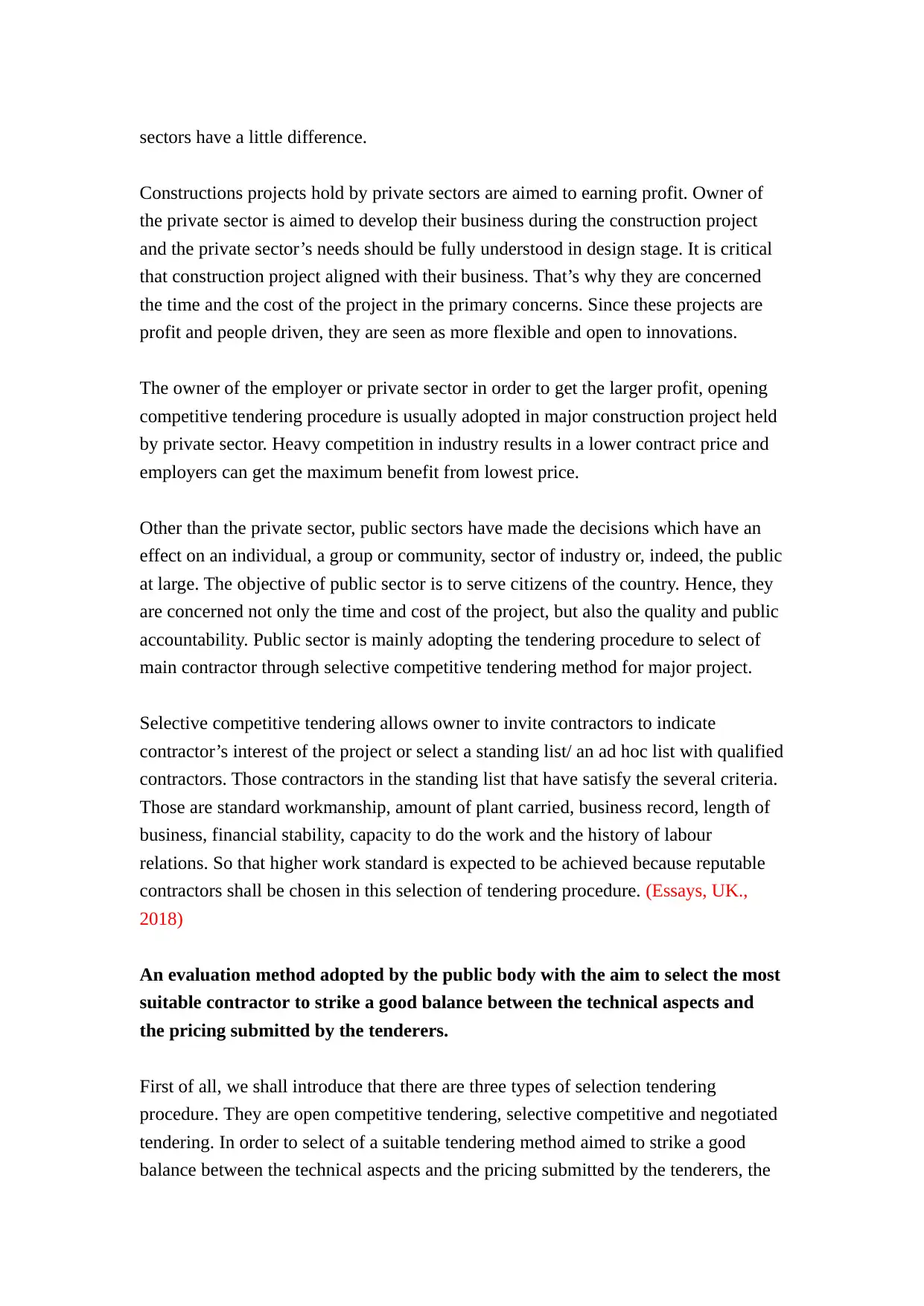
sectors have a little difference.
Constructions projects hold by private sectors are aimed to earning profit. Owner of
the private sector is aimed to develop their business during the construction project
and the private sector’s needs should be fully understood in design stage. It is critical
that construction project aligned with their business. That’s why they are concerned
the time and the cost of the project in the primary concerns. Since these projects are
profit and people driven, they are seen as more flexible and open to innovations.
The owner of the employer or private sector in order to get the larger profit, opening
competitive tendering procedure is usually adopted in major construction project held
by private sector. Heavy competition in industry results in a lower contract price and
employers can get the maximum benefit from lowest price.
Other than the private sector, public sectors have made the decisions which have an
effect on an individual, a group or community, sector of industry or, indeed, the public
at large. The objective of public sector is to serve citizens of the country. Hence, they
are concerned not only the time and cost of the project, but also the quality and public
accountability. Public sector is mainly adopting the tendering procedure to select of
main contractor through selective competitive tendering method for major project.
Selective competitive tendering allows owner to invite contractors to indicate
contractor’s interest of the project or select a standing list/ an ad hoc list with qualified
contractors. Those contractors in the standing list that have satisfy the several criteria.
Those are standard workmanship, amount of plant carried, business record, length of
business, financial stability, capacity to do the work and the history of labour
relations. So that higher work standard is expected to be achieved because reputable
contractors shall be chosen in this selection of tendering procedure. (Essays, UK.,
2018)
An evaluation method adopted by the public body with the aim to select the most
suitable contractor to strike a good balance between the technical aspects and
the pricing submitted by the tenderers.
First of all, we shall introduce that there are three types of selection tendering
procedure. They are open competitive tendering, selective competitive and negotiated
tendering. In order to select of a suitable tendering method aimed to strike a good
balance between the technical aspects and the pricing submitted by the tenderers, the
Constructions projects hold by private sectors are aimed to earning profit. Owner of
the private sector is aimed to develop their business during the construction project
and the private sector’s needs should be fully understood in design stage. It is critical
that construction project aligned with their business. That’s why they are concerned
the time and the cost of the project in the primary concerns. Since these projects are
profit and people driven, they are seen as more flexible and open to innovations.
The owner of the employer or private sector in order to get the larger profit, opening
competitive tendering procedure is usually adopted in major construction project held
by private sector. Heavy competition in industry results in a lower contract price and
employers can get the maximum benefit from lowest price.
Other than the private sector, public sectors have made the decisions which have an
effect on an individual, a group or community, sector of industry or, indeed, the public
at large. The objective of public sector is to serve citizens of the country. Hence, they
are concerned not only the time and cost of the project, but also the quality and public
accountability. Public sector is mainly adopting the tendering procedure to select of
main contractor through selective competitive tendering method for major project.
Selective competitive tendering allows owner to invite contractors to indicate
contractor’s interest of the project or select a standing list/ an ad hoc list with qualified
contractors. Those contractors in the standing list that have satisfy the several criteria.
Those are standard workmanship, amount of plant carried, business record, length of
business, financial stability, capacity to do the work and the history of labour
relations. So that higher work standard is expected to be achieved because reputable
contractors shall be chosen in this selection of tendering procedure. (Essays, UK.,
2018)
An evaluation method adopted by the public body with the aim to select the most
suitable contractor to strike a good balance between the technical aspects and
the pricing submitted by the tenderers.
First of all, we shall introduce that there are three types of selection tendering
procedure. They are open competitive tendering, selective competitive and negotiated
tendering. In order to select of a suitable tendering method aimed to strike a good
balance between the technical aspects and the pricing submitted by the tenderers, the
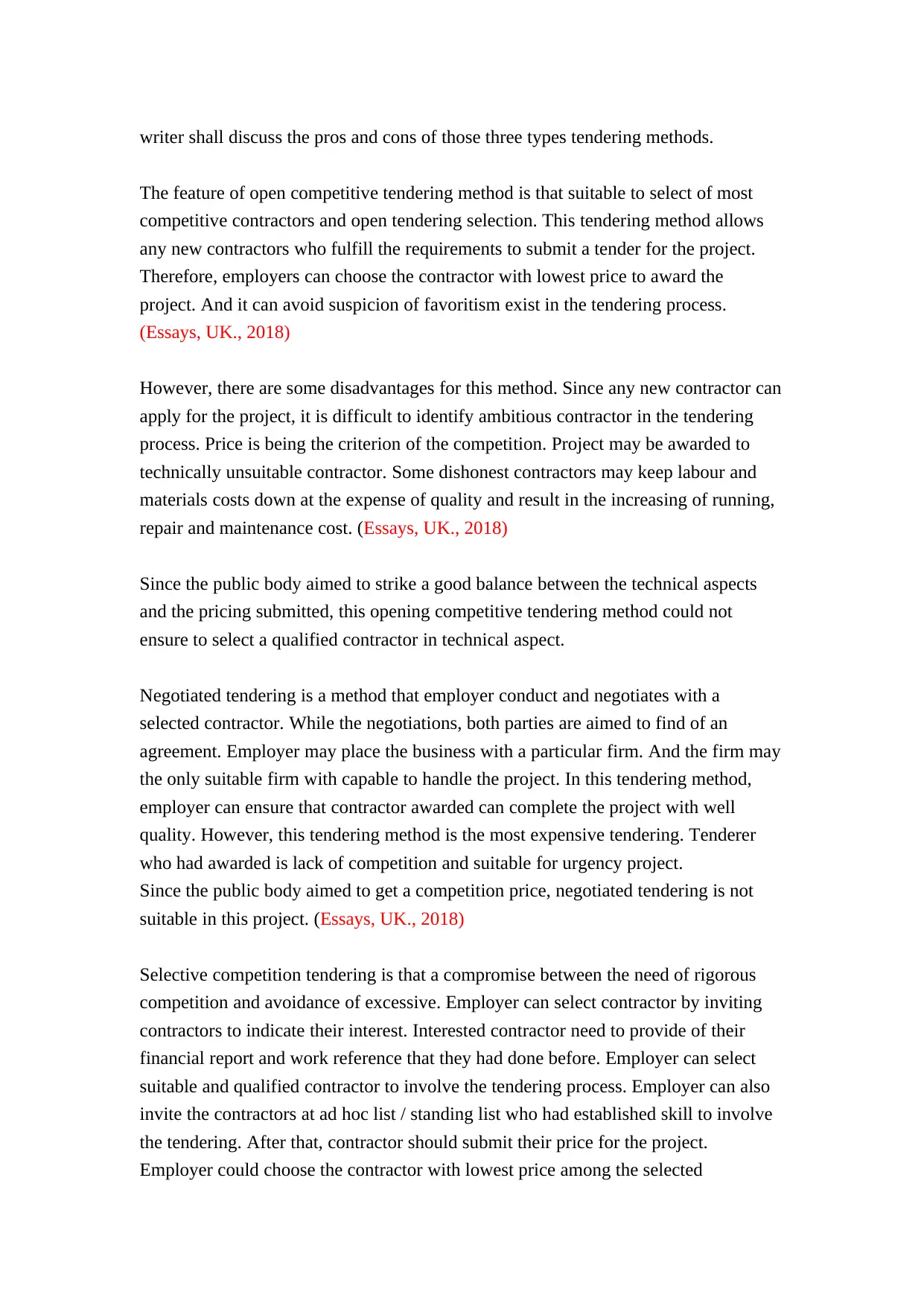
writer shall discuss the pros and cons of those three types tendering methods.
The feature of open competitive tendering method is that suitable to select of most
competitive contractors and open tendering selection. This tendering method allows
any new contractors who fulfill the requirements to submit a tender for the project.
Therefore, employers can choose the contractor with lowest price to award the
project. And it can avoid suspicion of favoritism exist in the tendering process.
(Essays, UK., 2018)
However, there are some disadvantages for this method. Since any new contractor can
apply for the project, it is difficult to identify ambitious contractor in the tendering
process. Price is being the criterion of the competition. Project may be awarded to
technically unsuitable contractor. Some dishonest contractors may keep labour and
materials costs down at the expense of quality and result in the increasing of running,
repair and maintenance cost. (Essays, UK., 2018)
Since the public body aimed to strike a good balance between the technical aspects
and the pricing submitted, this opening competitive tendering method could not
ensure to select a qualified contractor in technical aspect.
Negotiated tendering is a method that employer conduct and negotiates with a
selected contractor. While the negotiations, both parties are aimed to find of an
agreement. Employer may place the business with a particular firm. And the firm may
the only suitable firm with capable to handle the project. In this tendering method,
employer can ensure that contractor awarded can complete the project with well
quality. However, this tendering method is the most expensive tendering. Tenderer
who had awarded is lack of competition and suitable for urgency project.
Since the public body aimed to get a competition price, negotiated tendering is not
suitable in this project. (Essays, UK., 2018)
Selective competition tendering is that a compromise between the need of rigorous
competition and avoidance of excessive. Employer can select contractor by inviting
contractors to indicate their interest. Interested contractor need to provide of their
financial report and work reference that they had done before. Employer can select
suitable and qualified contractor to involve the tendering process. Employer can also
invite the contractors at ad hoc list / standing list who had established skill to involve
the tendering. After that, contractor should submit their price for the project.
Employer could choose the contractor with lowest price among the selected
The feature of open competitive tendering method is that suitable to select of most
competitive contractors and open tendering selection. This tendering method allows
any new contractors who fulfill the requirements to submit a tender for the project.
Therefore, employers can choose the contractor with lowest price to award the
project. And it can avoid suspicion of favoritism exist in the tendering process.
(Essays, UK., 2018)
However, there are some disadvantages for this method. Since any new contractor can
apply for the project, it is difficult to identify ambitious contractor in the tendering
process. Price is being the criterion of the competition. Project may be awarded to
technically unsuitable contractor. Some dishonest contractors may keep labour and
materials costs down at the expense of quality and result in the increasing of running,
repair and maintenance cost. (Essays, UK., 2018)
Since the public body aimed to strike a good balance between the technical aspects
and the pricing submitted, this opening competitive tendering method could not
ensure to select a qualified contractor in technical aspect.
Negotiated tendering is a method that employer conduct and negotiates with a
selected contractor. While the negotiations, both parties are aimed to find of an
agreement. Employer may place the business with a particular firm. And the firm may
the only suitable firm with capable to handle the project. In this tendering method,
employer can ensure that contractor awarded can complete the project with well
quality. However, this tendering method is the most expensive tendering. Tenderer
who had awarded is lack of competition and suitable for urgency project.
Since the public body aimed to get a competition price, negotiated tendering is not
suitable in this project. (Essays, UK., 2018)
Selective competition tendering is that a compromise between the need of rigorous
competition and avoidance of excessive. Employer can select contractor by inviting
contractors to indicate their interest. Interested contractor need to provide of their
financial report and work reference that they had done before. Employer can select
suitable and qualified contractor to involve the tendering process. Employer can also
invite the contractors at ad hoc list / standing list who had established skill to involve
the tendering. After that, contractor should submit their price for the project.
Employer could choose the contractor with lowest price among the selected
⊘ This is a preview!⊘
Do you want full access?
Subscribe today to unlock all pages.

Trusted by 1+ million students worldwide
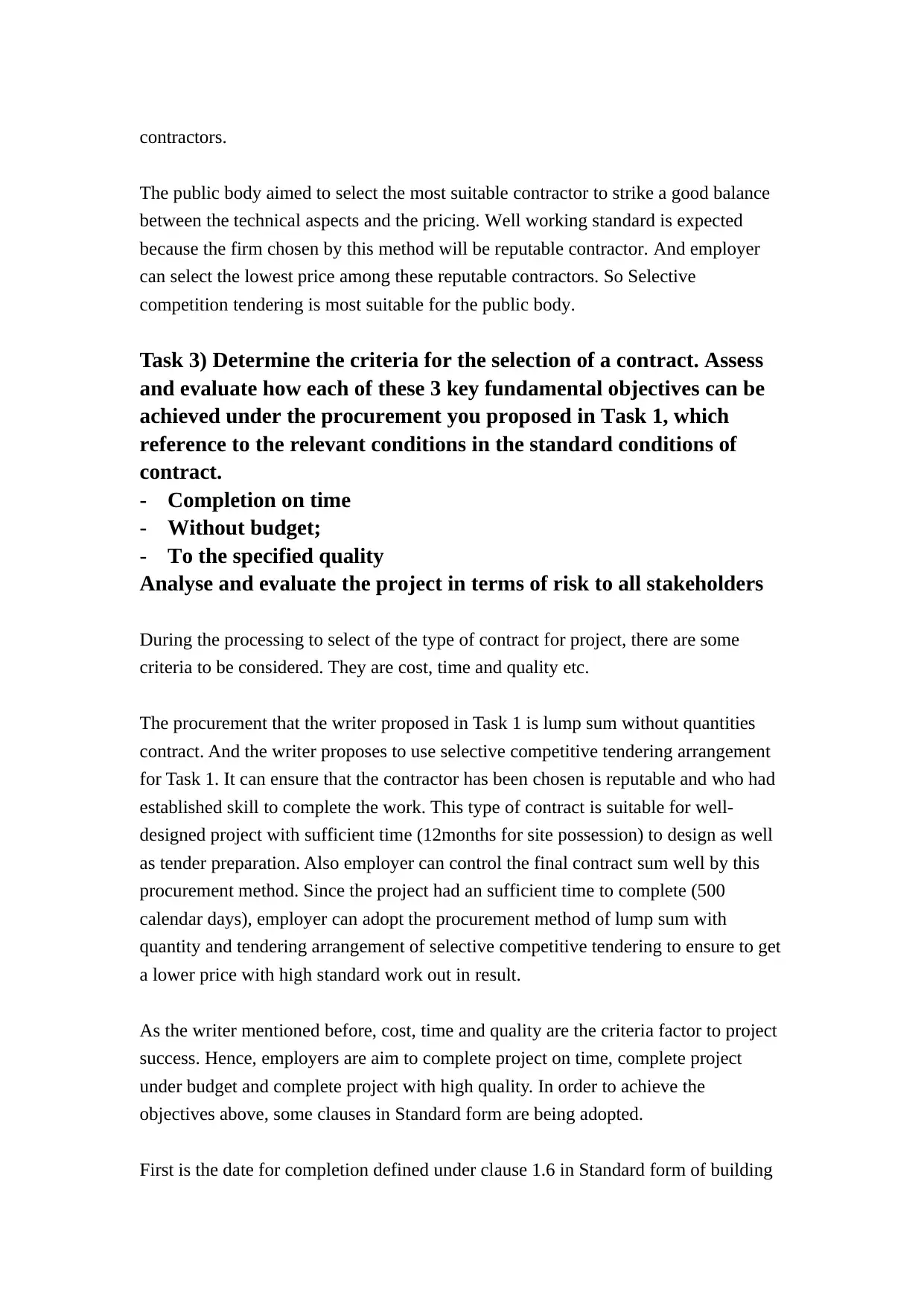
contractors.
The public body aimed to select the most suitable contractor to strike a good balance
between the technical aspects and the pricing. Well working standard is expected
because the firm chosen by this method will be reputable contractor. And employer
can select the lowest price among these reputable contractors. So Selective
competition tendering is most suitable for the public body.
Task 3) Determine the criteria for the selection of a contract. Assess
and evaluate how each of these 3 key fundamental objectives can be
achieved under the procurement you proposed in Task 1, which
reference to the relevant conditions in the standard conditions of
contract.
- Completion on time
- Without budget;
- To the specified quality
Analyse and evaluate the project in terms of risk to all stakeholders
During the processing to select of the type of contract for project, there are some
criteria to be considered. They are cost, time and quality etc.
The procurement that the writer proposed in Task 1 is lump sum without quantities
contract. And the writer proposes to use selective competitive tendering arrangement
for Task 1. It can ensure that the contractor has been chosen is reputable and who had
established skill to complete the work. This type of contract is suitable for well-
designed project with sufficient time (12months for site possession) to design as well
as tender preparation. Also employer can control the final contract sum well by this
procurement method. Since the project had an sufficient time to complete (500
calendar days), employer can adopt the procurement method of lump sum with
quantity and tendering arrangement of selective competitive tendering to ensure to get
a lower price with high standard work out in result.
As the writer mentioned before, cost, time and quality are the criteria factor to project
success. Hence, employers are aim to complete project on time, complete project
under budget and complete project with high quality. In order to achieve the
objectives above, some clauses in Standard form are being adopted.
First is the date for completion defined under clause 1.6 in Standard form of building
The public body aimed to select the most suitable contractor to strike a good balance
between the technical aspects and the pricing. Well working standard is expected
because the firm chosen by this method will be reputable contractor. And employer
can select the lowest price among these reputable contractors. So Selective
competition tendering is most suitable for the public body.
Task 3) Determine the criteria for the selection of a contract. Assess
and evaluate how each of these 3 key fundamental objectives can be
achieved under the procurement you proposed in Task 1, which
reference to the relevant conditions in the standard conditions of
contract.
- Completion on time
- Without budget;
- To the specified quality
Analyse and evaluate the project in terms of risk to all stakeholders
During the processing to select of the type of contract for project, there are some
criteria to be considered. They are cost, time and quality etc.
The procurement that the writer proposed in Task 1 is lump sum without quantities
contract. And the writer proposes to use selective competitive tendering arrangement
for Task 1. It can ensure that the contractor has been chosen is reputable and who had
established skill to complete the work. This type of contract is suitable for well-
designed project with sufficient time (12months for site possession) to design as well
as tender preparation. Also employer can control the final contract sum well by this
procurement method. Since the project had an sufficient time to complete (500
calendar days), employer can adopt the procurement method of lump sum with
quantity and tendering arrangement of selective competitive tendering to ensure to get
a lower price with high standard work out in result.
As the writer mentioned before, cost, time and quality are the criteria factor to project
success. Hence, employers are aim to complete project on time, complete project
under budget and complete project with high quality. In order to achieve the
objectives above, some clauses in Standard form are being adopted.
First is the date for completion defined under clause 1.6 in Standard form of building
Paraphrase This Document
Need a fresh take? Get an instant paraphrase of this document with our AI Paraphraser
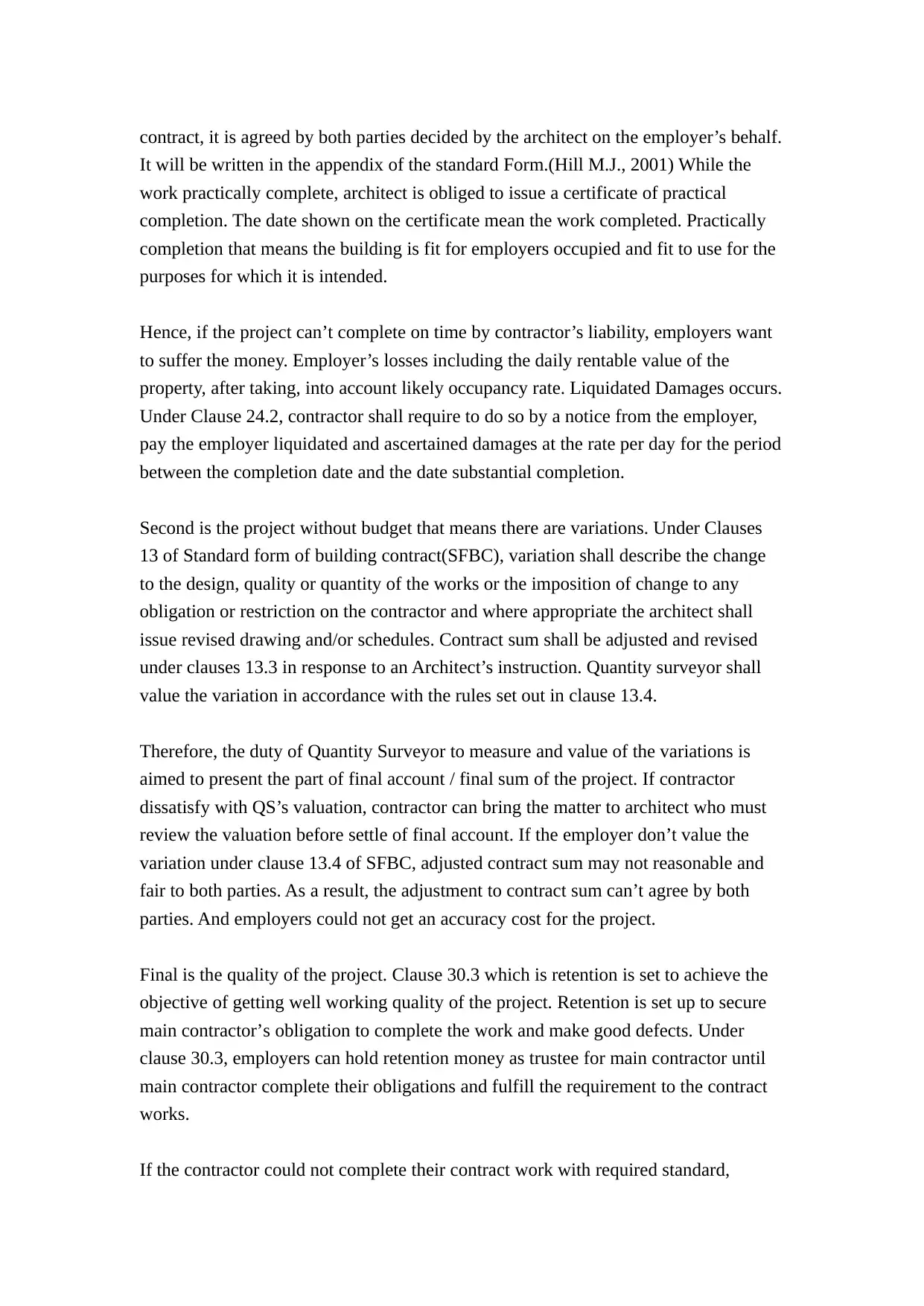
contract, it is agreed by both parties decided by the architect on the employer’s behalf.
It will be written in the appendix of the standard Form.(Hill M.J., 2001) While the
work practically complete, architect is obliged to issue a certificate of practical
completion. The date shown on the certificate mean the work completed. Practically
completion that means the building is fit for employers occupied and fit to use for the
purposes for which it is intended.
Hence, if the project can’t complete on time by contractor’s liability, employers want
to suffer the money. Employer’s losses including the daily rentable value of the
property, after taking, into account likely occupancy rate. Liquidated Damages occurs.
Under Clause 24.2, contractor shall require to do so by a notice from the employer,
pay the employer liquidated and ascertained damages at the rate per day for the period
between the completion date and the date substantial completion.
Second is the project without budget that means there are variations. Under Clauses
13 of Standard form of building contract(SFBC), variation shall describe the change
to the design, quality or quantity of the works or the imposition of change to any
obligation or restriction on the contractor and where appropriate the architect shall
issue revised drawing and/or schedules. Contract sum shall be adjusted and revised
under clauses 13.3 in response to an Architect’s instruction. Quantity surveyor shall
value the variation in accordance with the rules set out in clause 13.4.
Therefore, the duty of Quantity Surveyor to measure and value of the variations is
aimed to present the part of final account / final sum of the project. If contractor
dissatisfy with QS’s valuation, contractor can bring the matter to architect who must
review the valuation before settle of final account. If the employer don’t value the
variation under clause 13.4 of SFBC, adjusted contract sum may not reasonable and
fair to both parties. As a result, the adjustment to contract sum can’t agree by both
parties. And employers could not get an accuracy cost for the project.
Final is the quality of the project. Clause 30.3 which is retention is set to achieve the
objective of getting well working quality of the project. Retention is set up to secure
main contractor’s obligation to complete the work and make good defects. Under
clause 30.3, employers can hold retention money as trustee for main contractor until
main contractor complete their obligations and fulfill the requirement to the contract
works.
If the contractor could not complete their contract work with required standard,
It will be written in the appendix of the standard Form.(Hill M.J., 2001) While the
work practically complete, architect is obliged to issue a certificate of practical
completion. The date shown on the certificate mean the work completed. Practically
completion that means the building is fit for employers occupied and fit to use for the
purposes for which it is intended.
Hence, if the project can’t complete on time by contractor’s liability, employers want
to suffer the money. Employer’s losses including the daily rentable value of the
property, after taking, into account likely occupancy rate. Liquidated Damages occurs.
Under Clause 24.2, contractor shall require to do so by a notice from the employer,
pay the employer liquidated and ascertained damages at the rate per day for the period
between the completion date and the date substantial completion.
Second is the project without budget that means there are variations. Under Clauses
13 of Standard form of building contract(SFBC), variation shall describe the change
to the design, quality or quantity of the works or the imposition of change to any
obligation or restriction on the contractor and where appropriate the architect shall
issue revised drawing and/or schedules. Contract sum shall be adjusted and revised
under clauses 13.3 in response to an Architect’s instruction. Quantity surveyor shall
value the variation in accordance with the rules set out in clause 13.4.
Therefore, the duty of Quantity Surveyor to measure and value of the variations is
aimed to present the part of final account / final sum of the project. If contractor
dissatisfy with QS’s valuation, contractor can bring the matter to architect who must
review the valuation before settle of final account. If the employer don’t value the
variation under clause 13.4 of SFBC, adjusted contract sum may not reasonable and
fair to both parties. As a result, the adjustment to contract sum can’t agree by both
parties. And employers could not get an accuracy cost for the project.
Final is the quality of the project. Clause 30.3 which is retention is set to achieve the
objective of getting well working quality of the project. Retention is set up to secure
main contractor’s obligation to complete the work and make good defects. Under
clause 30.3, employers can hold retention money as trustee for main contractor until
main contractor complete their obligations and fulfill the requirement to the contract
works.
If the contractor could not complete their contract work with required standard,
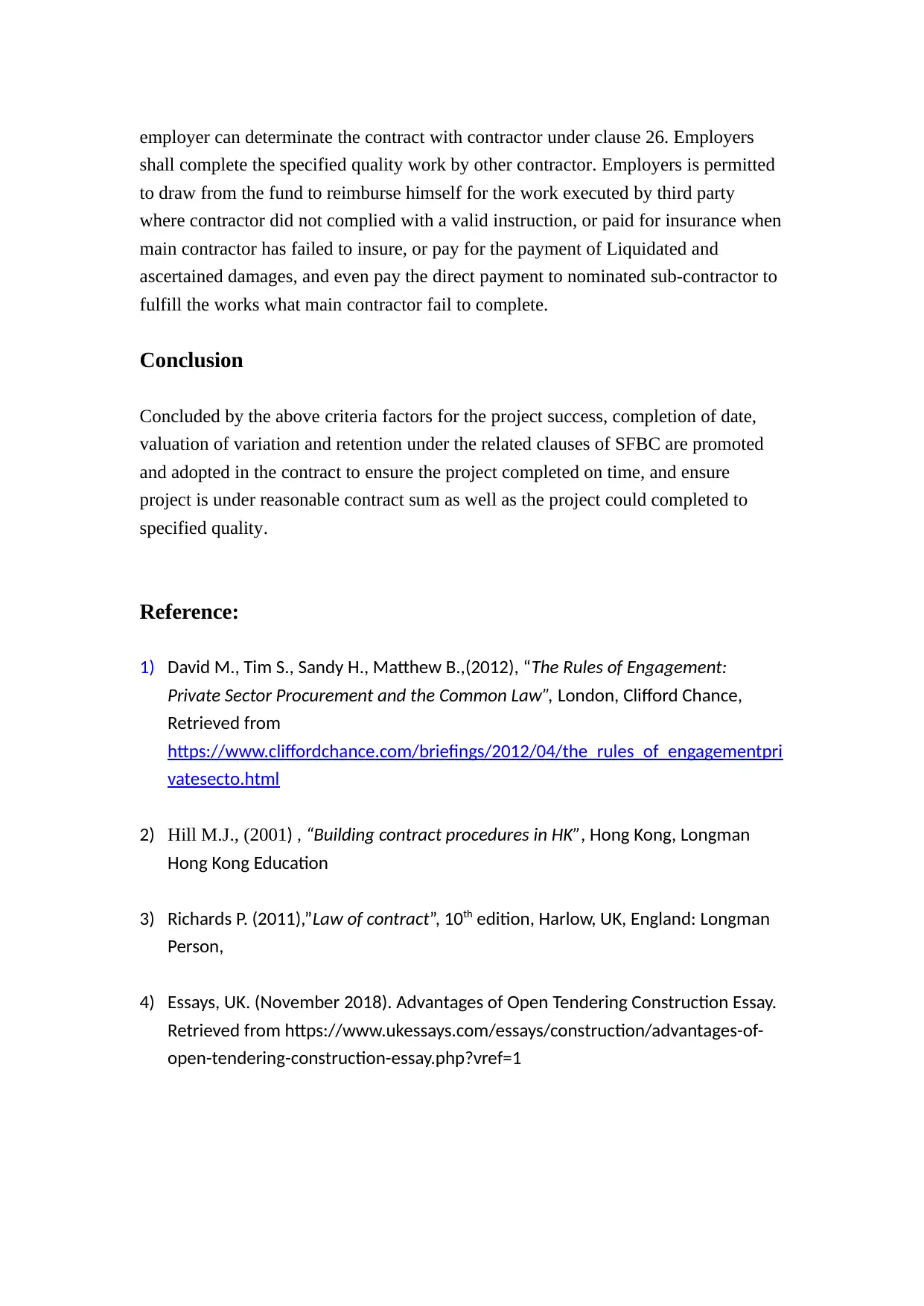
employer can determinate the contract with contractor under clause 26. Employers
shall complete the specified quality work by other contractor. Employers is permitted
to draw from the fund to reimburse himself for the work executed by third party
where contractor did not complied with a valid instruction, or paid for insurance when
main contractor has failed to insure, or pay for the payment of Liquidated and
ascertained damages, and even pay the direct payment to nominated sub-contractor to
fulfill the works what main contractor fail to complete.
Conclusion
Concluded by the above criteria factors for the project success, completion of date,
valuation of variation and retention under the related clauses of SFBC are promoted
and adopted in the contract to ensure the project completed on time, and ensure
project is under reasonable contract sum as well as the project could completed to
specified quality.
Reference:
1) David M., Tim S., Sandy H., Matthew B.,(2012), “The Rules of Engagement:
Private Sector Procurement and the Common Law”, London, Clifford Chance,
Retrieved from
https://www.cliffordchance.com/briefings/2012/04/the_rules_of_engagementpri
vatesecto.html
2) Hill M.J., (2001) , “Building contract procedures in HK”, Hong Kong, Longman
Hong Kong Education
3) Richards P. (2011),”Law of contract”, 10th edition, Harlow, UK, England: Longman
Person,
4) Essays, UK. (November 2018). Advantages of Open Tendering Construction Essay.
Retrieved from https://www.ukessays.com/essays/construction/advantages-of-
open-tendering-construction-essay.php?vref=1
shall complete the specified quality work by other contractor. Employers is permitted
to draw from the fund to reimburse himself for the work executed by third party
where contractor did not complied with a valid instruction, or paid for insurance when
main contractor has failed to insure, or pay for the payment of Liquidated and
ascertained damages, and even pay the direct payment to nominated sub-contractor to
fulfill the works what main contractor fail to complete.
Conclusion
Concluded by the above criteria factors for the project success, completion of date,
valuation of variation and retention under the related clauses of SFBC are promoted
and adopted in the contract to ensure the project completed on time, and ensure
project is under reasonable contract sum as well as the project could completed to
specified quality.
Reference:
1) David M., Tim S., Sandy H., Matthew B.,(2012), “The Rules of Engagement:
Private Sector Procurement and the Common Law”, London, Clifford Chance,
Retrieved from
https://www.cliffordchance.com/briefings/2012/04/the_rules_of_engagementpri
vatesecto.html
2) Hill M.J., (2001) , “Building contract procedures in HK”, Hong Kong, Longman
Hong Kong Education
3) Richards P. (2011),”Law of contract”, 10th edition, Harlow, UK, England: Longman
Person,
4) Essays, UK. (November 2018). Advantages of Open Tendering Construction Essay.
Retrieved from https://www.ukessays.com/essays/construction/advantages-of-
open-tendering-construction-essay.php?vref=1
⊘ This is a preview!⊘
Do you want full access?
Subscribe today to unlock all pages.

Trusted by 1+ million students worldwide
1 out of 9
Related Documents
Your All-in-One AI-Powered Toolkit for Academic Success.
+13062052269
info@desklib.com
Available 24*7 on WhatsApp / Email
![[object Object]](/_next/static/media/star-bottom.7253800d.svg)
Unlock your academic potential
Copyright © 2020–2025 A2Z Services. All Rights Reserved. Developed and managed by ZUCOL.





